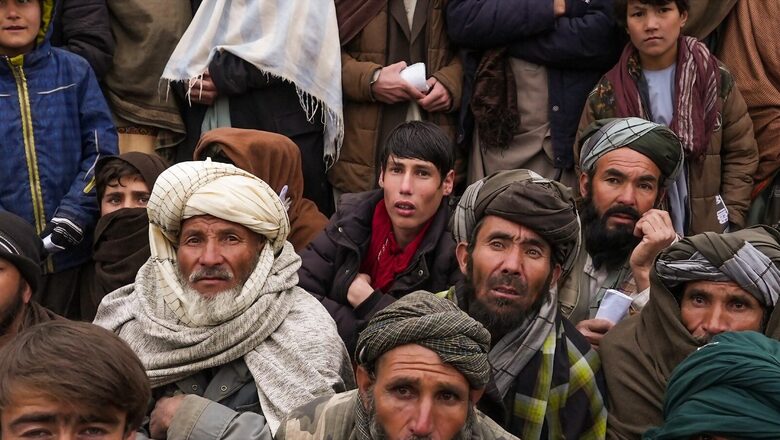
views
Fear grips the lives of people in various disputed regions around the world. Fear of several years of war and destruction and now the fear of a fatal global pandemic. The already hobbled healthcare systems have further been overwhelmed with high infection rates of Covid-19. As newer variants continue to keep coming up, the best possible way out of the situation is to get the maximum possible number of people vaccinated. However, vaccinating people in crisis zones has been fraught with difficulties thus far. Many of these areas have not even partially vaccinated one-fourth of their population. Rapid and concerted efforts in the coming months are critical to closing the vaccine distribution gap.
Vaccination Rates in War-Torn Zones
Syria, which has been living in the terror of death for more than a decade, has only been able to partially vaccinate 13.9 percent of the total population. Iraq’s single and double-dose vaccination rates are 26 percent and 18.3 percent, respectively. Ethiopia’s conflict began 16 months ago, and the effects have had an influence on vaccination rates, with only 18.5 percent of the population fully vaccinated. The Russian invasion of Ukraine has effectively interrupted the already sluggish vaccination effort. The most recent data on vaccination rates in Ukraine are from February 27th and show that only 35% of people received their first vaccination dose. Afghanistan which is currently under the Taliban regime has just partially vaccinated 12% of its people.
Also Read: Amid Covid Pandemic, Tuberculosis Patients Are Becoming a Casualty of Neglect
The Challenge of Vaccine Hesitancy
Vaccine hesitancy has been designated as one of the top ten global health hazards by the World Health Organisation. Despite months of vaccination campaigns, one of the main causes for low coverage in these areas is persistent scepticism. Yemen, for example, received around 360 thousand doses of AstraZeneca under the worldwide COVAX vaccination sharing scheme in April 2021. However, the country had unusually low turnout rates since people feared that taking a shot during Ramadan would break their fast. Furthermore, people have perceived vaccines to be ineffective when they have already had the infection once. The authorities there have failed to remove these misconceptions from the minds of people. A study conducted in Syria which was published in November 2021 stated that merely 31% of the people surveyed were sure of taking the vaccine. False claims and misinformation on social media are also said to have raised scepticism about the vaccine among Syrian healthcare staff.
In Ethiopia, vaccine hesitancy is not just limited to the general public. It extends to the healthcare workers (HCWs) as well. A study published in December 2021 stated that nearly two-thirds (60.3%) of HCWs were hesitant to use the Covid-19 vaccine. Ethiopians believe that the Covid-19 infection is less severe than that of other countries. Furthermore, hesitancy stemmed from a lack of confidence in the vaccine’s efficacy against the illness in comparison to other preventive methods.
Logistical and Other Problems related to Mass Vaccination
Vaccine hesitancy is one of the most significant, although not the only, factors contributing to these countries’ delayed and low immunisation rates. Several other logistical challenges have jeopardised these countries’ vaccination initiatives. Problems such as insufficient vaccine availability and administration place a significant strain on the healthcare system. In the case of Afghanistan, the USA was supposed to deliver vaccine supplies in August 2021. However, the efforts were deeply hampered and stalled because of the Taliban insurgency.
Ukraine, which was invaded by Russia in February, was way late in starting its vaccination campaign in comparison to its other European counterparts. Because of the country’s low vaccination coverage, most Ukrainians are susceptible to Covid-19 infection. The country is running low on medical supplies. With war devastating public health infrastructure in Ukraine, testing and vaccination coverage have definitely taken a backseat.
Because of their failure to secure early arrangements with manufacturing corporations, vulnerable nations such as Somalia continue to confront a shortage of vaccines. There are no large-scale investments in healthcare infrastructure. The ongoing civil war in Somalia adds to the strain on the country’s already precarious healthcare infrastructure.
In Libya, the case of low vaccination rates is resulting due to some other reasons. There are low levels of both awareness of vaccine accessibility and registration mechanism for non-Libyan population to receive the vaccine. Moreover, an assessment of migrants’ knowledge and perception of Covid-19 done in 2021 revealed that 51% of the migrants feared being discriminated against at health facilities and hence the hurdle for vaccination increases. The migrants also said that health officials look upon them as carriers of the virus.
How to Deal with the Problem at Hand
There is clearly a wide knowledge gap regarding how disease spreads and how vaccination can save their lives. More and more people need to be made aware and confident about taking vaccine shots. Nationwide campaigns initiated by governments need to be paced up. Professionally trained skilled communication personnel need to be sent on the ground to alleviate the issues of vaccine hesitancy amongst people. Stereotypes and myths are generally community and region-specific. Local organisations and media parties need to come together to fight against these misconceptions.
Also Read: Current Booster Dose Policy is Not Enough. India Needs More Booster Shots To Beat The Fourth Wave
Aside from that, substantial funding and massive international support are essential to keep these populations safer and healthier. WHO has been collaborating with Hungary, Poland, the Republic of Moldova, and Romania to ensure that all vaccination and vaccination programmes, including COVID-19, include Ukrainian refugees. These countries border Ukraine and have seen a huge influx of refugees. Similar actions are required to get these vulnerable groups out of the grip of the pandemic.
To limit the rate of infection and save lives from present and any future variants, vaccinating the maximum number of people is a must. Most conflicted regions lack access to safe water, food and sanitation facilities. Low vaccination rates are a world concern. Where rich countries are completing third doses and are moving towards lives of normalcy, it should be kept in mind that no one is safe until everyone is safe.
More global resources and funds are needed to save people’s lives. Strong political leadership and worldwide solidarity are capable of accomplishing this. The goal is to advance ideas for health sustainability and equity for all.
Mahek Nankani is Assistant Programme Manager, The Takshashila Institution. The views expressed in this article are those of the authors and do not represent the stand of this publication.
Read all the Latest Opinion News and Breaking News here




















Comments
0 comment